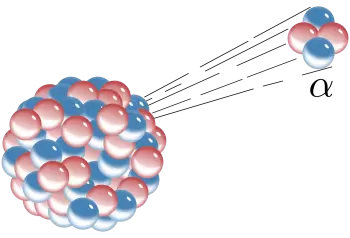
A radioactive nuclide or radionuclide is an unstable nuclide and therefore degenerates by emitting ionizing radiation.
When a radionuclide emits radioactivity it reaches a more stable state, which requires less energy than before and, in general, transforms into another different nuclide (or into the same one, but less excited, if it has emitted gamma radioactivity), which can also be radioactive or not being radioactive.
This radioactive process occurs in principle spontaneously, but humans have learned to provoke it artificially. In both cases the resulting radioactivity has exactly the same characteristics.
What is a radionuclide like?
Radionuclides are characterized by having a finite half-life, which can range from small fractions of a second to thousands of years. In fact, some of them have such a long half-life that it has not yet been possible to quantify it experimentally. There are even those that had been considered, and for certain practical applications, stable.
Of the currently known nuclides, there are ninety that are theoretically stable and two hundred and fifty-five that have not been observed to disintegrate.
On the other hand, there are almost twice as many, about six hundred and fifty, who have had radioactivity observed and who have a half-life of at least one hour.
About three thousand radionuclides with a half-life of more than one hour are known on Earth, most of which (about 90%) are produced by humans, about two thousand four hundred with a half-life of less than one hour, and still others. so unstable that their half-life is very short.
Use and applications of radionuclides
Radionuclides are applied to nuclear energy technology to obtain electrical energy, in industry (quality controls, etc.), nuclear medicine (radiotherapy, etc.) and for nuclear weapons (basically for the propulsion of vehicles and tools). to kill).
The use of radionuclide implies serious environmental risks (radioactive contamination) and health risks (radiotoxicity, radiation poisoning, etc.).
Naturally occurring radionuclides, such as uranium or plutonium, exist in finite quantities on Earth, so they must be used in a sustainable way. On the other hand, its use generates radioactive waste, which can be very dangerous. Currently, the only treatment that is usually done is to cover them until their radioactivity is close to natural.
The possible treatments for which it would take more than thirty years to do so (all spent nuclear fuel from nuclear power plants and for military purposes, for example) are still in the theory, research or experimentation phase.
Hazards and effects on human health
The presence of radionuclides in our environment poses substantial risks to human health, highlighting several threats that deserve our attention:
- Internal radiation : Unlike external radiation, radionuclide exposure involves radiation from within the body. This type of internal radiation can directly affect internal organs, significantly increasing the risk of diseases such as cancer.
- Accumulation in organs : Many radionuclides share chemical similarities with elements essential for the human body. As a result, the body absorbs them and accumulates them in specific organs, where they continue to emit radiation over time. This prolonged buildup can cause irreparable tissue damage.
- Ingestion through food : The main route of entry of radionuclides into the human body is the ingestion of contaminated food. Elements such as cesium-137 and strontium-90, with long half-lives, persist in the food chain, representing a constant danger to those who consume contaminated products.
- Genetic diseases : Ionizing radiation generated by radionuclides can damage the genetic material in cells, increasing the risk of mutations and genetic diseases. This danger extends to future generations, creating long-term concerns about hereditary health.
Dangers of radionuclides in food
It has been shown that the risks associated with ingesting foods that exceed the permitted limits of radionuclides outweigh, in many cases, the effects of external radiation. When the radiation source resides within the body, it directly impacts internal organs, meaning that even a small dose can trigger significant health consequences.
Most radionuclides share similar chemical properties with the constituent elements of the human body. Consequently, the human organism assimilates them, confusing them with the necessary elements, and retains them in the corresponding organs. Once lodged in these organs, radionuclides continue to emit radiation, making it impossible for the person to protect themselves from this exposure.
The main route of entry of radionuclides into the human body is through food, a phenomenon that has maintained its relevance over decades. This is attributed to the fact that long-lived radionuclides, such as cesium-137 and strontium-90, which are especially dangerous, contaminate food. Due to their long half-life, around 30 years, these elements retain their activity over time, persistently integrating into the food chain.